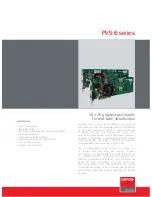
Chapter 6
90
In software, specify a gain of 1 for analog output operations.
Conversion Modes
DT302, DT304, and DT322 boards can perform single-value operations only. Use software to
specify the range, gain, and analog output channel (among other parameters), then output the
data from the specified channel. You cannot specify a clock source, trigger source, or buffer.
Single-value operations stop automatically when finished; you cannot stop a single-value
operation.
Data Format
Data from the host computer must use offset binary data encoding for analog output signals.
Using software, specify the data encoding as binary.
In software, you need to supply a code that corresponds to the analog output value you want
the board to output. To convert a voltage to a code, use the following formulas:
LSB = FSR
2
N
Code = Vout
–
offset
LSB
where,
•
LSB
is the least significant bit.
•
FSR
is the full-scale range. For the DT300 Series, the full-scale analog output range is 5 for
the unipolar range of 0 to 5 V; 10 for the unipolar range of 0 to 10 V or the bipolar output
range of ±5 V; or 20 for the bipolar range or ±10 V.
•
N
is the number of bits of the D/A converter. For the DT302 and DT304 boards,
N
is 12.
For the DT322 board,
N
is 16.
•
Code
is the raw count used by the software to represent the voltage.
•
Vout
is the analog voltage.
•
Offset
is the minus full-scale value. The minus full-scale value is 0.0 V for the unipolar
range and either
−
5 V for the ±5 V range or
−
10 V for the ±10 V range.
For example, assume that you are using a DT302 board with a unipolar output range of 0 to 5
V. The minus full-scale value is 0 V. If you want to output a voltage of 4.7 V, determine the
code value as follows:
LSB = 5 = 0.001221 V
4096
Code = 4.7 V
–
0 V
0.001221 V
Code = 3849 = 0F09h
Summary of Contents for DT300 Series
Page 1: ...DT300 Series UM 16501 T User s Manual Title Page ...
Page 4: ......
Page 10: ...Contents 10 ...
Page 14: ...About this Manual 14 ...
Page 15: ...15 1 Overview Features 16 Supported Software 18 Accessories 19 Getting Started Procedure 20 ...
Page 21: ...Part 1 Getting Started ...
Page 22: ......
Page 58: ...Chapter 4 58 ...
Page 69: ...Part 2 Using Your Board ...
Page 70: ......
Page 106: ...Chapter 6 106 ...
Page 124: ...Chapter 8 124 ...
Page 130: ...Chapter 9 130 ...
Page 156: ...Appendix C 156 ...
Page 164: ...Index 164 ...
















































